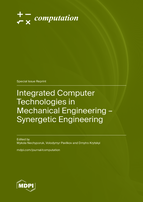Integrated Computer Technologies in Mechanical Engineering – Synergetic Engineering
A special issue of Computation (ISSN 2079-3197). This special issue belongs to the section "Computational Engineering".
Deadline for manuscript submissions: closed (20 June 2022) | Viewed by 20407
Special Issue Editors
Interests: aerospace engineering; math modeling
Special Issues, Collections and Topics in MDPI journals
Interests: radar; positioning; navigation; engineering
Special Issues, Collections and Topics in MDPI journals
Interests: artificial Intelligence; computer vision; UaV
Special Issues, Collections and Topics in MDPI journals
Special Issue Information
This Special Issue will publish a set of selected papers from the International Conference “Integrated Computer Technologies in Mechanical Engineering” (ICTM 2021: ictm.khai.edu), which will be held on 28–29 October 2021 in Kharkiv, Ukraine (due to the health crisis, the conference may be held online). You are invited to submit a contribution to the conference for consideration in this Special Issue (Paper submission at https://easychair.org).
Topics of the conferences include but are not limited to the following:
- Information technology in the design and manufacture of engines;
- Information technology in the creation of rocket space systems;
- Aerospace engineering;
- Control systems and engineering;
- Transport systems and logistics;
- Big data and data science;
- Nano-modeling;
- Artificial intelligence and smart systems;
- Networks and communication;
- Cyberphysical systems and IoE;
- Software engineering and IT infrastructure;
- Information modeling;
- Project management and business informatics;
- Hyper reality;
- Robotics and UAV;
- Smart energy and grids;
- Cybersecurity and safety;
- Signal and image processing;
- Remote sensing radars.
Prof. Dr. Mykola Nechyporuk
Dr. Vladimir Pavlikov
Dr. Dmitriy Kritskiy
Guest Editors
Manuscript Submission Information
Manuscripts should be submitted online at www.mdpi.com by registering and logging in to this website. Once you are registered, click here to go to the submission form. Manuscripts can be submitted until the deadline. All submissions that pass pre-check are peer-reviewed. Accepted papers will be published continuously in the journal (as soon as accepted) and will be listed together on the special issue website. Research articles, review articles as well as short communications are invited. For planned papers, a title and short abstract (about 100 words) can be sent to the Editorial Office for announcement on this website.
Submitted manuscripts should not have been published previously, nor be under consideration for publication elsewhere (except conference proceedings papers). All manuscripts are thoroughly refereed through a single-blind peer-review process. A guide for authors and other relevant information for submission of manuscripts is available on the Instructions for Authors page. Computation is an international peer-reviewed open access monthly journal published by MDPI.
Please visit the Instructions for Authors page before submitting a manuscript. The Article Processing Charge (APC) for publication in this open access journal is 1800 CHF (Swiss Francs). Submitted papers should be well formatted and use good English. Authors may use MDPI's English editing service prior to publication or during author revisions.
Keywords
- artificial intelligence and smart systems
- robotics and UAV
- mechanical engineering
- creation of rocket space systems






